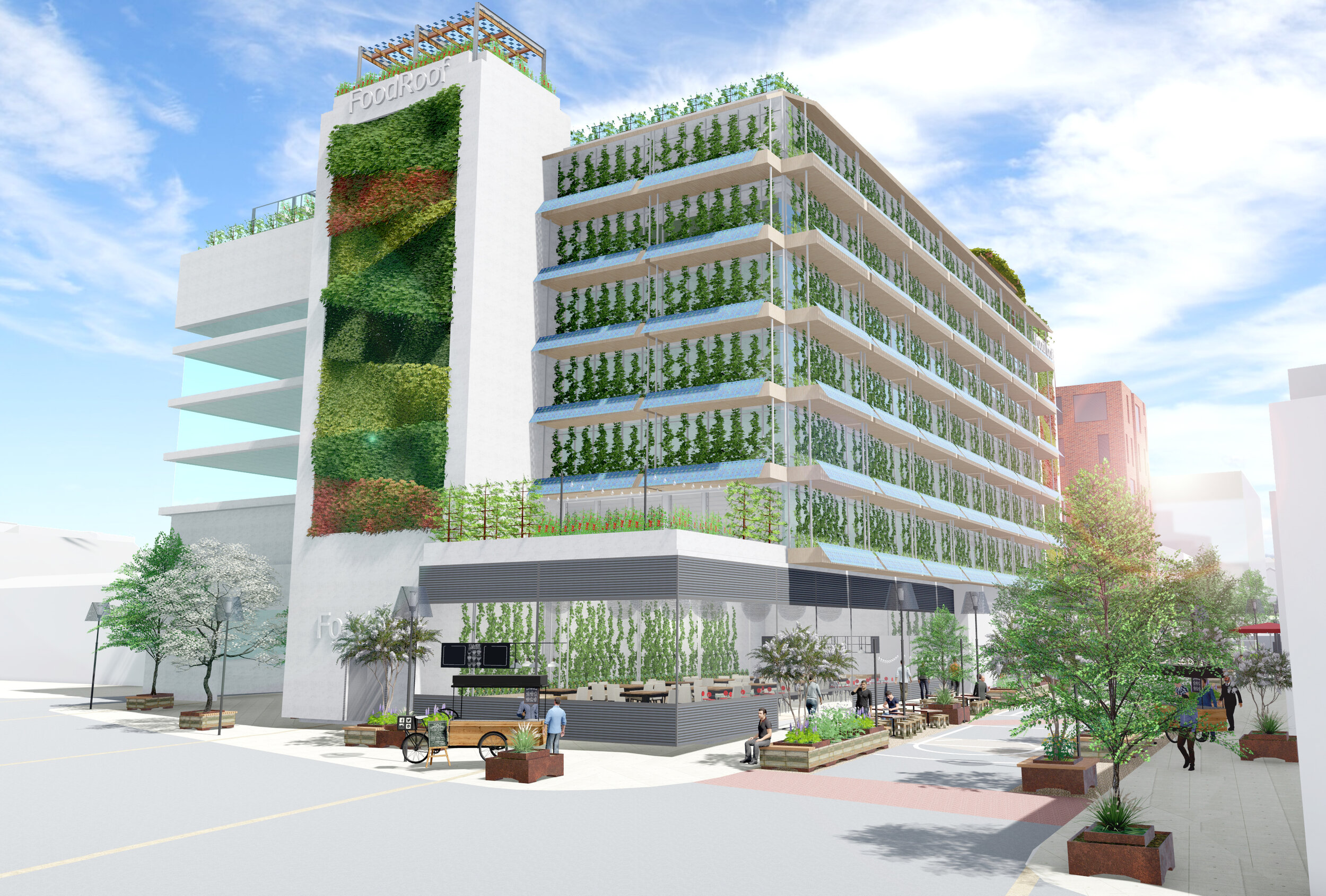Jun 23, 2021
Can ‘Agritecture’ Help Us Adapt To Climate Change? These Architects Think So.

Future City Food Hub. Concept by Chris Jones & Brian McCarthy.
CONTENT SOURCED FROM ARCHDAILY
With global population on the rise, natural resources used to produce food becoming increasingly threatened by climate change, and urban sprawl continuing to out-compete farmland, more creative solutions to growing, distributing, and consuming food are urgently needed. One crucial group we’ll have to rely on to build a more food-secure future? Architects and urban designers.
Perhaps you’ve already seen some of the utopian renderings of futuristic cities filled with skyscraper farms floating around the internet. While inspiring, they tend to miss the mark on pragmatism. From a financial, engineering, and even horticultural perspective, the majority of these concepts would never be viable. And if they’re not viable, how can they be sustainable?
Addressing this nagging question is what first inspired entrepreneur Henry Gordon-Smith to start writing about the intersection of architecture and agriculture in 2011, under the name Agritecture.
“Agriculture and architecture have been intertwined since the dawn of human settlement,” explains Gordon-Smith. “But in recent history, we’ve lost that connection. ‘Agritecture’ is about bringing that connection back and making it work for a modern society through smart planning and data-driven solutions.”
By educating early-stage entrepreneurs and better preparing them for the realities of operating an urban farming business, Agritecture became the leading urban agriculture consultancy globally, with 130+ clients in over 50 cities.
Now, Agritecture has expanded their scope of impact through the launch of a new software platform, Agritecture Designer.
Designer helps people in any part of the world plan viable urban farms through educational lessons and financial modeling tools, all based on best practices and data collected over many years. A growing network of equipment and finance partners helps to then connect these project developers with the technology and capital needed to get their plans off the ground.
This year, Agritecture put out a call for architects and designers to address several challenge areas pertaining to future urban food scenarios, using Agritecture Designer for best practices and data models to make their solutions more viable.
Here are some highlights from these innovative concepts. Which of these would you most want to see become reality?

Autonomous Vehicle Future. Concept by Eugene Gurevich, Charles Huang, Ted Klingensmith, annd Athmane Aouchiche.
Autonomous Vehicle Future - Concept by Eugene Gurevich, Charles Huang, Ted Klingensmith, Athmane Aouchiche of RAND Engineering & Architecture
With the need for parking lots diminishing, the RAND team envisioned repurposing the 200,000 square-foot concrete IKEA parking lot in Paramus, NJ for local food production. Designer enabled them to explore the viability of a phased conversion of this large parking facility using a mix of greenhouses, vertical farms, and outdoor community spaces showcasing the retailer’s products. RAND hopes to pitch this concept to IKEA soon.

Retail Apocalypse. Concept by Zeynab Matar, Andrea Baraggia, and Mohamed Adel El-Begermie.
Retail Apocalypse - Concept by Zeynab Matar, Andrea Baraggia, Mohamed Adel El-Begermie
Milan’s abandoned Ex-Macello site was once a communal slaughterhouse comprising 15 hectares. With a desire to upgrade the site by integrating innovative food production with a new shopping experience, this team of architects used Designer to nail down the financials, resource usage, and yields of their grand vision.
Future City Food Hub - Concept by Chris Jones of Feeding Cities & Brian McCarthy of Cork Rooftop Farm

Future City Food Hub. Concept by Chris Jones & Brian McCarthy.
Taking inspiration from the real-world Cork Rooftop Farm, this concept imagines the conversion of a multistory downtown carpark into a food hub, featuring an indoor vertical farm and rooftop greenhouse in the same building as food processing and retail space. With Designer, Jones was able to determine which crops would be most practical to grow in vertical farms versus greenhouses versus raised beds, producing a total annual yield of more than 100,000 pounds on-site.
Urban Drought - Concept by Jorge Gerini of Sordo Madaleno Arquitectos

Urban Drought. Concept by Jorge Gerini.
85% of Mexico is currently in drought, threatening farmers’ capacity to produce food. Altozano Querétaro is a mixed use development with a pronounced slope, enabling scenic views, sunlight, and shaded spaces. Through realistic financial calculations derived from Designer, Jorge’s team plans to create a community-focused model centered around resilient food production and greenspace, with two greenhouses at either end of a central linear park, and a vertical farm in the same building as a farm-to-table restaurant.

Remote Northern Communities. Concept by Hala Al Amine.
Remote Northern Communities - Concept by Hala Al Amine
Al Amine focused her concept on communities that are geographically isolated and suffer from harsh weather conditions and a short growing season. The igloo-inspired “Arctic Eye” is a geodesic dome creating a greenhouse at its periphery and a vertical farm in its center, growing produce that supports a healthy diet and tolerance to the cold. Designer estimated a substantial annual yield of more than 160,000 pounds per year.


